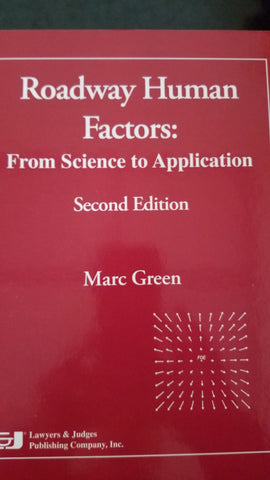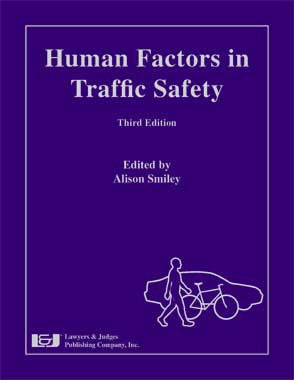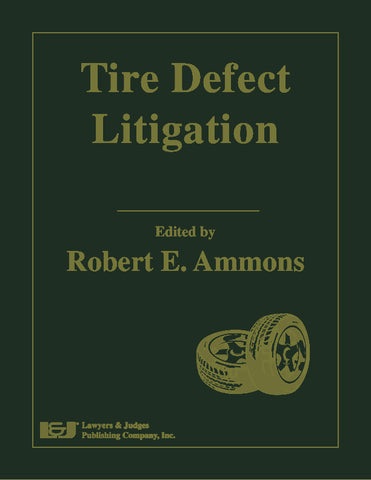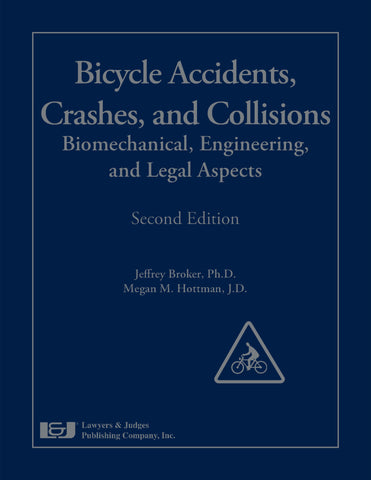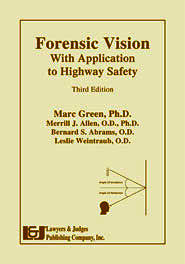
Forensic Vision with Application to Highway Safety with CD-Rom 3rd Edition
-
Authors: Marc Green, Merrill J. Allen, Bernard S. Abrams, Leslie Weintraub
-
ISBN 10: 1-933264-54-3
-
ISBN 13: 978-1-933264-54-7
-
Copyright Date Ed: June 23, 2008
-
Pages: 496 pages
-
Binding Information: Casebound with DVD
- Size: 7 ✕ 10 Inches (US)
Written for attorneys, law enforcement personnel, optometrists, highway engineers, automobile manufacturers, legislators, expert witnesses, and other related professionals, Forensic Vision: with Application to Highway Safety is your reference for accident cases with a vision component. While it does have a focus on the roadway environment, it is primarily about vision and the visual science that applies to analyzing all types of transportation accidents and non-transportation accidents such as auto accidents, pedestrian accidents, falls, medical errors, warnings, eyewitness identification, and more.
This new edition is divided into four sections for ease of use. The first three are: Basic Vision—the operation of normal vision; Clinical Vision—impairments of vision due to disease and aging; and Roadway Vision—factors affecting vision in the roadway environment. They cover the scientific aspects, including scientific background information and experimental and investigation design and methodology. You will also find this book to be practical in nature. The fourth section, Forensic Vision — application of the preceding material to accident analysis — and the "Forensic Vision Tool Kit" present extensive information on analyzing accident scenarios involving visibility as well as tips for use of pictorial evidence in the courtroom, techniques for testifying about vision in court, and more. It is filled with practical advice for professionals working on vision cases, and includes seven appendices with additional helpful information.
When reconstructing the accident, vision is always a component. You need to know what questions are vital to ask, when to call the expert, what evidence will be needed, what kind of help can be expected, and how to structure testimony. Forensic Vision: With Application to Highway Safety provides you with a basic reference in the vision area as well as a starting point for more advanced research.
TOPICS INCLUDE
- Conspicuity
- Attention
- Space and depth perception
- Contrast thresholds
- Color and vision
- Color and vision
- Physics of light
- Forensic vision and human factors in the courtroom
- Forensic aspects of visual perception
- Physiology of the eye
- Vision and aging
- Drugs and alcohol and their effects on vision
- Systemic diseases and visual impairment
- Eye diseases and visual impairment
- Vision tests and prescribing for driving
- Vision requirements for driving
- Visual problems in the automobile
- Visual hazards on streets and highways
- The practice of forensic visibility
- Visibility analysis
- Visibility and human factors evaluation
- Measurement and evaluation of motor vehicle lighting
- Pedestrian accident analysis
- Collision analysis
- Breaking and stopping
- Visual analysis of pictorial evidence
- The eye is not a camera
- Vision and behavior
- Vision and cognitive information processing
- Psycophysical concepts of vision
- Use of expert witnesses
- Questions that might be asked
- Documentation needed
- Visual angles and visual acuity
- Geometric optics
Table of Contents
Preface: From Judkin’s Law To Daubert Criteria
Chapter 1: Introduction to Vision
1.1 Introduction
A. Vision = Sensation + Perception (+Attention)
B. Vision Is Complex, Naïve Realism Is Simple
1.2 Embedding Vision In Behavior
A. Open-Loop and Closed-Loop Behavior
B. Cognitive Information Processing
C. Behavioral Sequences
1.3 Example: The Underride Accident
1.4 Conclusion
Chapter 2: Psychophysics
2.1 Introduction
2.2 Psychophysical Concepts
A. Classical Psychophysics
B. Signal Detection Theory
2.3 Magnitude Scaling
2.4 Conclusion
Chapter 3: Physics, Physiology, Psychology
3.1 Introduction
3.2 Physics
A. Light
B. Optics
3.3 Physiology
A. Eye Anatomy and Optics
B. Eye Muscles
C. The Retina
D. Visual Modes
E. Higher Visual Pathways
3.4 Brightness
A. Brightness and Reflectance
B. Adaptation
3.5 Color
A. Basic Color Vision
B. Color Deficiency
C. Color and Brightness
3.6 Conclusion
Chapter 4: Attention and Conspicuity
4.1 Introduction
4.2 Laws Of Attention
4.3 Types of Attention
A. Source of Control
B. Filtering Criteria
4.4 Conspicuity
A. Sensory Conspicuity
B. Cognitive Conspicuity
4.5 What Is Inattention?
4.6 Causes Of Attentional "Failure"
A. Insufficient Capacity
B. Attentional Set
4.7 Conclusion
Chapter 5: Systemic Diseases and Highway Safety
5.1 Metabolic Diseases
A. Diabetes mellitus
B. Thyroid disease
C. Hyperparathyroidism and hypoparathyroidism
D. Posterior pituitary insufficiency
E. Anterior pituitary insufficiency <br>F. Pituitary tumor
G. Adrenal cortical hypersecretion (Cushing’s disease), and hypo-secretion (Addison’s disease)
H. Hyperfunction of the adrenal medulla
5.2 Cardiovascular Disease
A. Congestive heart failure
B. Arrhythmias
C. Angina pectoris (cardiac pain)
D. Hypertension
E. Hypotension
5.3 Cerebrovascular Attacks (CVA)
Chapter 6: Vision Tests
6.1 Introduction
6.2 Case History
6.3 Preliminary Examinations
A. Visual acuity
B. Ocular motility
C. Visual fields
D. Pupil dynamics
E. Equating retinal illumination
F. Lids and cornea
G. Lens and vitreous
H. Fundus study
I. Intraocular pressure
J. Photo convulsive behavior
6.4 Refraction
A. Objective tests
B. Subjective tests
6.5 Five Fundamental Variables of Ocular Muscle Coordination
A. Distance phoria
B. Positive fusional convergence
C. Negative fusional convergence
D. Amplitude of accommodation
E. A.C.A. ratio
6.6 Special Tests
A. Aniseikonia
B. Color vision
C. Stereopsis
D. Night visual performance
E. Visual fields
F. Reaction time
G. Glaucoma
Chapter 7: Eye Disease and Highway Safety
7.1 Introduction
7.2 Corneal Dystrophies/Degeneration/Scars
7.3 Cataracts
7.4 Glaucoma
7.5 Peripheral Visual Field Loss
7.6 Macular Degeneration/Maculopathies
7.7 Retinitis Pigmentosa
7.8 Diabetic Retinopathy
7.9 One-Eyed and Spectacle Corrected Aphakes
7.10 Postoperative Cataract and Refractive Surgery
7.11 Ocular Muscle Imbalance
7.12 Color Blindness
7.13 Depth Perception
7.14 Age
Chapter 8: Drugs and Alcohol Affecting Highway Safety
8.1 Introduction
A. Narcotic analgesics (pain relievers)
B. CNS depressants
C. Dissociative anesthetics (PCP and analogs)
D. Cannabis (marijuana and hashish)
E. Hallucinogens (psychedelics)
F. Inhalants
G. CNS stimulants
H. Ophthalmic agents
8.2 HGN: Horizontal Gaze Nystagmus
A. HGN prosecution
B. HGN defense
Chapter 9: Visual Aging
9.1 Introduction
A. Refresher on Visual System and its Function
B. The Definition of Normal
9.2 Anatomical / Physiological Changes with Age
A. Optical Components
B. Neural Components
C. Extraocular Muscles and Eye Movements
9.3 Visual Function Changes with Age
A. Functions which Decline with Age
B. Visual functions which remain relatively unchanged with age
C. Relation of Sensory to Perceptual and Cognitive Deficits
9.4 Implications of Visual Aging Changes for "Normal" Behavior and Environmental Design
A. Summary and General Solutions
B. Mobility
C. Driving: Are Older Drivers Really Worse Drivers?
9.5 Conclusions
Chapter 10: Visual Problems in the Automobile
10.1 Eye Position on the Highway
10.2 Glare
10.3 Dirt and Scratches on the Windshield
10.4 Windshield Tint
10.5 Distortions
10.6 Obstructions and the Rear-View Mirror
10.7 Instrument Panel Visibility
10.8 Headlights
A. Aim
B. Filament shields
C. Sleepy eye shields
D. Disappearing headlights
E. All weather head lighting system
10.9 Signal Visibility
A. Front signals
B. Rear signals
C. Flash rate
D. Dirt
10.10 Vehicle Visibility
Chapter 11: Visual Hazards on Streets and Highways
11.1 Nighttime Hazards
A. Inadequate illumination and blacktop pavements
B. Improper use of reflectors
C. Pedestrians: A double hazard and a double right
D. Rain and fog hazards
E. Railroad crossings
F. Trucks
G. Black versus white tires
H. One to four am
I. Headlight laws
11.2 Daytime Hazards
A. Sun and sky glare
B. Atmospheric boil
C. Mirage effects
D. Camouflage effects
E. Rain, mist, snow, and fog
Chapter 12: Measurement and Evaluation of Motor Vehicle Lighting: A Systematic Approach
12.1 Preface
12.2 Establishing the Test Range
A. Desirable qualities of the test range
B. Construction of the test range
12.3 Taking Measurements
12.4 Final Presentation of Data-Profile Plots
Chapter 13: Visibility Analysis 1: Introduction
13.1 Introduction
13.2 Step 1: Determine Whether a Direct Sightline Existed
13.3 Step 2: Assess the Target and Background Luminance
A. Direct Measurement of Luminance
B. Indirect Luminance Determination
13.4 Step 3: Compute the Physical Contrast Of the Target On The Background
10.8 Headlights
A. Aim
B. Filament shields
C. Sleepy eye shields
D. Disappearing headlights
E. All weather head lighting system
10.9 Signal Visibility
A. Front signals
B. Rear signals
C. Flash rate
D. Dirt
10.10 Vehicle Visibility
A. Direct Looking
B. Viewing Through A Transparent Surface
C. Glare Effects
D. Atmospheric Effects
E. Adverse Weather Effects
13.5 Conclusion
Chapter 14: Visibility Analysis 2: Contrast Thresholds
14.1 Introduction
14.2 Step 4: Determine Contrast Threshold
A. Using Data And Models
B. Adrian Model Variables
C. Additional Visual Variables
D. Contrast Multipliers
14.3 Alternatives To Contrast Thresholds
A. Acuity
B. The Twilight Envelope
14.4 Conclusion
Chapter 15: Pedestrian Accident Analysis
15.1 Introduction
15.2 Constraints On Pedestrian Avoidance
A. Perception-reaction time
B. Stopping distance
C. Contrast Detection
15.3 Analysis of A Pedestrian Collision
A. Basic Analysis
B. Sensory and Cognitive Analysis
15.4 Pedestrian Behavior Often Causes An Accident
A. Violate Driver Expectation
B. Overconfidence
C. Distraction
D. Drugs and Alcohol
E. Child Behavior and Accidents
15.5 Conclusion
Chapter 16: Collision Analysis
16.1 Introduction
16.2 Zero-Angle Collisions
A. Rear-End Collision
B. Head-On Collisions while Overtaking
16.3 Right-Angle Collision
A. Judging Time To Arrival
B. Peripheral Detection
C. Braking and Swerving
16.4 Conclusion
Chapter 17: "How Long Does It Take to Stop?": Methodological Analysis of Driver Perception-Brake Times
Chapter 18:Visual Analysis of Pictorial Evidence
18.1 Introduction
18.2 Image Fidelity
A. Optical Factors
B. Photometric Factors
C. Display Media
D. Image Fidelity Summary
18.3 Psychophysical and Perceptual Fidelity
A. Psychophysical Information Not Captured By Pictures
B. Viewer and Situational Variables
C. Cognitive Variables
D. The Psychologist’s Fallacy: The Harmful Effects Of Pictures
E. Psychophysical and Perceptual Fidelity Summary
18.4 Conclusion
Chapter 19: Forensic Vision Toolkit
19.1 The Practice of Forensic Visibility
A. Introduction
B. A Hypothetical Case
1C. The Practitioner’s Role
19.2 Questions 448
A. Work/Note Questions You May Be Asked to Answer in Order to Qualify as a Nighttime Visibility Expert
B. Questions You May Be Asked Relating to Nighttime Accidents on Cross-Examination
19.3 Nighttime Visibility Expert on Direct Examination
A. Hypothetical Case Review and Decision
B. Use of Qualified Expert Witness with a Visibility Background
19.4 Suggested List of Documentation Which May Be Needed for Visibility and Human Factors Evaluation
Appendix A : Color References
Appendix B: Geometric Optics
Appendix C: Psychophysical Laws
Appendix D: Recommended Sources
Appendix E: Cone of Vision
Appendix F: Relationship of Visual Angles/Visual Acuity
Appendix G:Twelve Things You Should Know About Vision and Accidents

